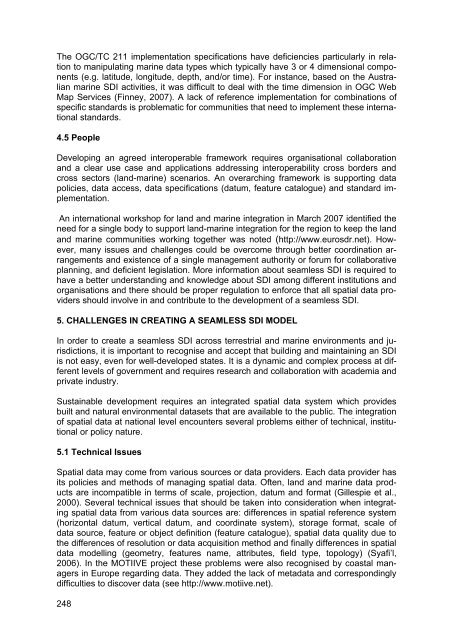SDI Convergence - Global Spatial Data Infrastructure Association
SDI Convergence - Global Spatial Data Infrastructure Association
SDI Convergence - Global Spatial Data Infrastructure Association
Create successful ePaper yourself
Turn your PDF publications into a flip-book with our unique Google optimized e-Paper software.
The OGC/TC 211 implementation specifications have deficiencies particularly in relation<br />
to manipulating marine data types which typically have 3 or 4 dimensional components<br />
(e.g. latitude, longitude, depth, and/or time). For instance, based on the Australian<br />
marine <strong>SDI</strong> activities, it was difficult to deal with the time dimension in OGC Web<br />
Map Services (Finney, 2007). A lack of reference implementation for combinations of<br />
specific standards is problematic for communities that need to implement these international<br />
standards.<br />
4.5 People<br />
Developing an agreed interoperable framework requires organisational collaboration<br />
and a clear use case and applications addressing interoperability cross borders and<br />
cross sectors (land-marine) scenarios. An overarching framework is supporting data<br />
policies, data access, data specifications (datum, feature catalogue) and standard implementation.<br />
An international workshop for land and marine integration in March 2007 identified the<br />
need for a single body to support land-marine integration for the region to keep the land<br />
and marine communities working together was noted (http://www.eurosdr.net). However,<br />
many issues and challenges could be overcome through better coordination arrangements<br />
and existence of a single management authority or forum for collaborative<br />
planning, and deficient legislation. More information about seamless <strong>SDI</strong> is required to<br />
have a better understanding and knowledge about <strong>SDI</strong> among different institutions and<br />
organisations and there should be proper regulation to enforce that all spatial data providers<br />
should involve in and contribute to the development of a seamless <strong>SDI</strong>.<br />
5. CHALLENGES IN CREATING A SEAMLESS <strong>SDI</strong> MODEL<br />
In order to create a seamless <strong>SDI</strong> across terrestrial and marine environments and jurisdictions,<br />
it is important to recognise and accept that building and maintaining an <strong>SDI</strong><br />
is not easy, even for well-developed states. It is a dynamic and complex process at different<br />
levels of government and requires research and collaboration with academia and<br />
private industry.<br />
Sustainable development requires an integrated spatial data system which provides<br />
built and natural environmental datasets that are available to the public. The integration<br />
of spatial data at national level encounters several problems either of technical, institutional<br />
or policy nature.<br />
5.1 Technical Issues<br />
<strong>Spatial</strong> data may come from various sources or data providers. Each data provider has<br />
its policies and methods of managing spatial data. Often, land and marine data products<br />
are incompatible in terms of scale, projection, datum and format (Gillespie et al.,<br />
2000). Several technical issues that should be taken into consideration when integrating<br />
spatial data from various data sources are: differences in spatial reference system<br />
(horizontal datum, vertical datum, and coordinate system), storage format, scale of<br />
data source, feature or object definition (feature catalogue), spatial data quality due to<br />
the differences of resolution or data acquisition method and finally differences in spatial<br />
data modelling (geometry, features name, attributes, field type, topology) (Syafi’l,<br />
2006). In the MOTIIVE project these problems were also recognised by coastal managers<br />
in Europe regarding data. They added the lack of metadata and correspondingly<br />
difficulties to discover data (see http://www.motiive.net).<br />
248

















